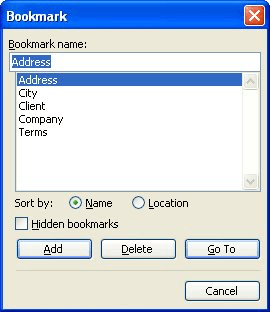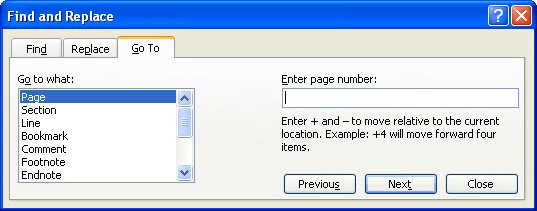Written by Allen Wyatt (last updated March 29, 2022)
This tip applies to Word 97, 2000, 2002, and 2003
If you are creating standard templates for your company, you may want to go one step further and make sure the cursor (insertion point) is positioned at a particular location whenever a new document is created that is based on the template. This can come in handy, as it ensures that the insertion point is at the proper place to begin typing in the new document.
This is a relatively easy process to do. Follow these steps:

Figure 1. The Bookmark dialog box.

Figure 2. The Go To tab of the Find and Replace dialog box.
That's it! The next time you create a document based on the template, the AutoRun macro will automatically execute, and you will jump to the designated spot.
Note:
WordTips is your source for cost-effective Microsoft Word training. (Microsoft Word is the most popular word processing software in the world.) This tip (1569) applies to Microsoft Word 97, 2000, 2002, and 2003.

Comprehensive VBA Guide Visual Basic for Applications (VBA) is the language used for writing macros in all Office programs. This complete guide shows both professionals and novices how to master VBA in order to customize the entire Office suite for their needs. Check out Mastering VBA for Office 2010 today!
Double-click on a Word document while using Windows Explorer, and the Word program should start with the document ...
Discover MoreNeed to store some information in a plain text file? It's easy to do when you use a macro.
Discover MoreIf you need to make sure that the fonts in your document can be used by another person or on a different system, you'll ...
Discover MoreFREE SERVICE: Get tips like this every week in WordTips, a free productivity newsletter. Enter your address and click "Subscribe."
2024-01-24 11:43:01
Jim Epler
Microsoft Word for Mac (Microsoft 360) doesn't permit macros to be saved in document templates, unfortunately. Otherwise, cool tip!
Got a version of Word that uses the menu interface (Word 97, Word 2000, Word 2002, or Word 2003)? This site is for you! If you use a later version of Word, visit our WordTips site focusing on the ribbon interface.
Visit the WordTips channel on YouTube
FREE SERVICE: Get tips like this every week in WordTips, a free productivity newsletter. Enter your address and click "Subscribe."
Copyright © 2024 Sharon Parq Associates, Inc.
Comments